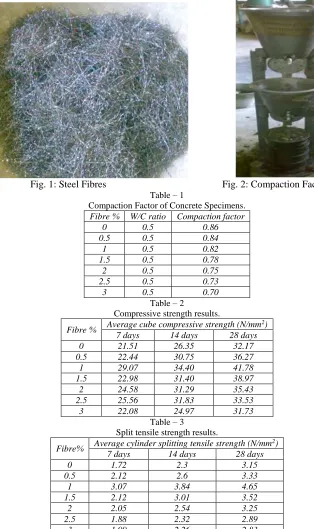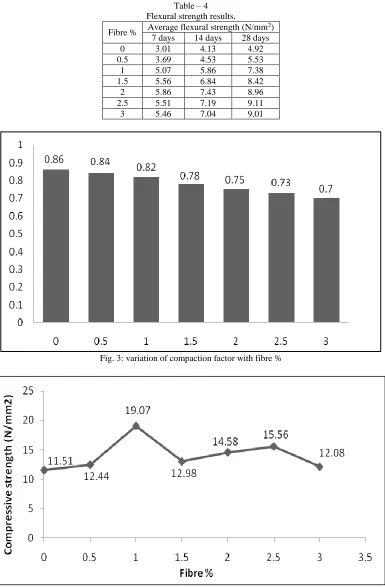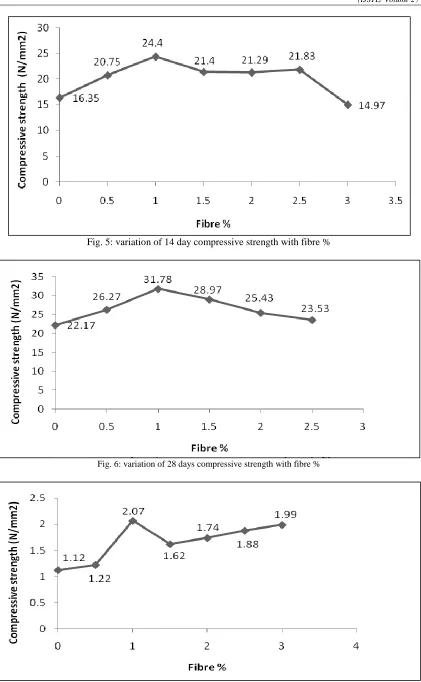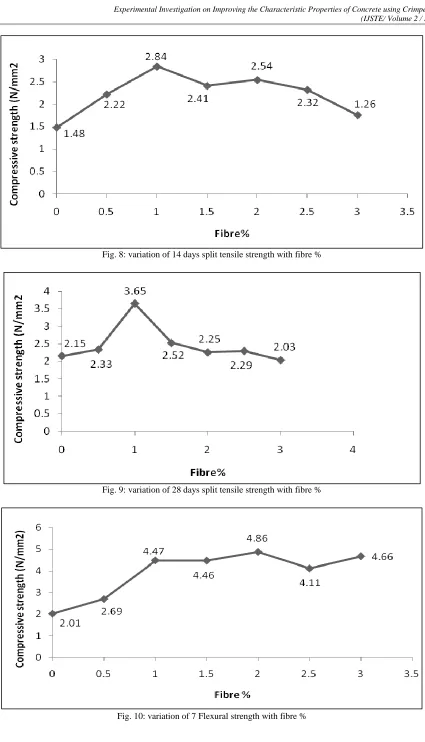Experimental Investigation on Improving the
Characteristic Properties of Concrete using
Crimped Steel Fibres
Zahid Bashir Bhat Danish Iqbal
Lecturer Assistant Engineer
Department of Civil Engineering PWD (R&B Department)
NIT Sgr J&K
Sahil Bhat Muneeb Anwar Shah
Project Specialist Civil Engineer
Ericsson Al-Madad Infratech
Irfan Latief Lecturer
Department of Civil Engineering KITE Polytechnic Rangret
Abstract
Concrete is strong in compression, as the aggregate efficiently carries the compressive load. However, it is weak in tension as the cement paste holding the aggregate in place can crack, allowing the structure to fail. It also has low energy absorption capacity and negligible ductility. Addition of fibres can impart ductility to concrete and substantially increase the energy absorption characteristics and its ability to withstand cyclic/repeated monotonic shocks and impact loading. In the present work, an effort is made to study the possible improvements in the characteristic properties of concrete using crimped steel fibres. Crimped steel fibres with varying percentage of 0.5%, 1%, 1.5%, 2%, 2.5% and 3% were added in M-20 Concrete specimens. The concrete specimens were tested for 7 days, 14 day and 28 day compressive strength, flexural strength and splitting tensile strength and the results obtained were compared with those of normal concrete mix without fibres. The optimum dosage of fibres that could be used without harming the properties of concrete was also assessed. The results concluded that the addition of 1% fibres by volume leads to considerable improvement in early as well as long term compressive strength, split tensile strength and flexural strength of concrete. Compressive strength of M-30 was obtained by 1% addition of fibres to designed concrete mix of M-20.
Keywords: Ductility, Steel fibres, Compressive strength, Splitting tensile strength, flexural strength
________________________________________________________________________________________________________
I. INTRODUCTION
Concrete carries flaws and micro-cracks both in the material and at the interfaces even before an external load is applied. These defects and micro-cracks emanate from excess water, bleeding, plastic settlement, thermal and shrinkage strains and stress concentrations imposed by external restraints. Under an applied load, distributed micro-cracks propagate coalesce and align themselves to produce macro-cracks. When loads are further increased, conditions of critical crack growth are attained at the tips of the macro-cracks and unstable and catastrophic failure is precipitated. The micro and macro-fracturing processes described above, can be favorably modified by adding short, randomly distributed fibers of various suitable materials. Fibers not only suppress the formation of cracks, but also abate their propagation and growth. Soon after placement, evaporation of the mix water and the autogenous process of concrete hydration create shrinkage strains in concrete. If restrained, this contraction can cause stresses far in excess of those needed to cause cracking. In spite of every effort, plastic shrinkage cracking remains a serious concern, particularly in large surface area placements like slabs on grade, thin surface repairs, patching and shotcrete linings. With large surface areas, fibers engage water in the mix and reduce bleeding and segregation. The result is that there is less water available for evaporation and less overall free shrinkage [1]. When combined with post-crack bridging capability of fibers, fibers reduce crack widths and cracks areas when concrete is retrained [2].
effectively bridging across macro-cracks. This post-peak macro-crack bridging is the primary reinforcement mechanism in the majority of commercial fiber reinforced concrete composites.
Fibres work with concrete utilizing two mechanisms: the spacing mechanism and the crack bridging mechanism. The spacing mechanism requires a large number of fibres well distributed within the concrete matrix to arrest any existing micro-crack that could potentially expand and create a sound crack. The second mechanism termed crack bridging requires larger straight fibres with adequate bond to concrete. Steel fibres are considered a prime example of this fiber type that is commonly referred to as large diameter fibres or macro fibres. Essentially, fiber act as crack arrestor restricting the development of cracks and thus transforming an inherently brittle matrix i.e. Portland cement with its low tensile and impact resistance, into a strong composite with superior crack resistance, improved ductility and distinctive post-cracking behavior prior to failure.[4] In this research, crimped steel fibres are added to concrete in dosage range of 0.5% to 3% by volume. Concrete specimens with varying fibre percentage were tested for compressive strength, splitting tensile strength and flexural strength. The results obtained were compared with results of normal M-20 concrete mix without fibres and it was found that maximum increase in compressive strength, splitting tensile strength and flexural strength at 7 days age, 14 days age and 28 days age occurred for concrete mix containing 1% fibres by volume.
II. MATERIALS USED
Cement and Aggregates:
Khyber ordinary Portland cement of 43 grade confining to IS 8112 [5] was used throughout the work. Fine aggregates used throughout the work comprised of clean river sand with maximum size of 4.75mm conforming to zone II as per IS383-1970 [6] with specific gravity of 2.6. Coarse aggregates used consisted of machine crushed stone angular in shape passing through 20mm IS sieve and retained on 4.75mm IS sieve with specific gravity of 2.7.
Steel Fibres:
Steel fibres of aspect ratio of 40 were used as an additive to improve the behavioral characteristics of concrete. Fig. 1 shows Crimped Steel fibres.
III. EXPERIMENTAL INVESTIGATION
Mix Proportion:
The concrete mix design was proposed by using IS 10262 [7]. The grade of concrete used was M-20 with water to cement ratio of 0.5.
Test on Fresh Concrete:
The workability of all concrete mixtures was determined through compaction factor test. The ratio of weight of concrete filled cylinder without compaction to the weight of the cylinder after full compaction was reported as compaction factor. Fig. 2 sho ws the equipment for compaction factor test. The compaction factor test was performed according to IS 1199-1959 [8].
Tests on hardened Concrete:
From each concrete mixture, cubes of size 150mm x 150mm x 150mm, 150mm x 300mm cylinders and 500mm x 100mm x 100mm beams were casted for the determination of compressive strength, splitting tensile strength and flexural strength respectively. The concrete specimens were cured under normal conditions as per IS 516-1959 [9] and were tested at 7 days, 14 days and 28days for determining compressive strength as per IS 516-1959 [10], splitting tensile strength as per IS 5816-1999 [11] and flexural strength as per IS516-1959[12].
IV. RESULTS AND DISCUSSION
Fresh concrete:
The compaction factor of all the mixtures is represented in TABLE 1. Decrease in compaction factor was observed in fresh concrete samples containing fibres as compared to compaction factor of normal concrete. The variation of compaction factor with varying fibre content is depicted in Fig. 3.
Hardened Concrete:
Compressive Strength:
The maximum compressive strength measured was 65%, 49% and 43% more than that of reference mix at 7 days, 14 days and 28 days respectively, corresponding to concrete mix containing 1% fibre by volume.
Splitting Tensile Strength:
The splitting tensile strength tests are presented in TABLE 3. Splitting tensile strength witnessed an increase of 85%, 92% and 70% at 7, 14 and 28 days of age respectively, corresponding to concrete mix containing 1% fibre by volume.
Flexural Strength:
The flexural strength tests are presented in TABLE 4. Flexural strength witnessed an increase of 122%, 55% and 63% at 7, 14 and 28 days of age respectively, corresponding to concrete mix containing 1% fibre by volume. However, maximum increase of 141%, 105% and 207% in flexural strength at the age of 7, 14 and 28 days was obtained on fibre addition of 2% by volume. Fig. 4, 5 and 6 present compressive strength of all mixtures at 3, 7 and 28 days respectively. Fig. 7, 8 and 9 present flexural strength of all mixtures at 3, 7 and 28 days respectively. Fig. 10, 11 and 12 present splitting tensile strength of all mixtures at 3, 7 and 28 days respectively.
Fig. 1: Steel Fibres Fig. 2: Compaction Factor test Table – 1
Compaction Factor of Concrete Specimens. Fibre % W/C ratio Compaction factor
0 0.5 0.86
0.5 0.5 0.84
1 0.5 0.82
1.5 0.5 0.78
2 0.5 0.75
2.5 0.5 0.73
3 0.5 0.70
Table – 2
Compressive strength results.
Fibre % Average cube compressive strength (N/mm 2) 7 days 14 days 28 days
0 21.51 26.35 32.17
0.5 22.44 30.75 36.27
1 29.07 34.40 41.78
1.5 22.98 31.40 38.97
2 24.58 31.29 35.43
2.5 25.56 31.83 33.53
3 22.08 24.97 31.73
Table – 3
Split tensile strength results.
Fibre% Average cylinder splitting tensile strength (N/mm 2)
7 days 14 days 28 days
0 1.72 2.3 3.15
0.5 2.12 2.6 3.33
1 3.07 3.84 4.65
1.5 2.12 3.01 3.52
2 2.05 2.54 3.25
2.5 1.88 2.32 2.89
Table – 4 Flexural strength results.
Fibre % Average flexural strength (N/mm 2) 7 days 14 days 28 days
0 3.01 4.13 4.92
0.5 3.69 4.53 5.53
1 5.07 5.86 7.38
1.5 5.56 6.84 8.42
2 5.86 7.43 8.96
2.5 5.51 7.19 9.11
3 5.46 7.04 9.01
Fig. 3: variation of compaction factor with fibre %
Fig. 5: variation of 14 day compressive strength with fibre %
Fig. 6: variation of 28 days compressive strength with fibre %
Fig. 8: variation of 14 days split tensile strength with fibre %
Fig. 9: variation of 28 days split tensile strength with fibre %
Fig. 11: variation of 14 Flexural strength with fibre %
Fig. 12: variation of 28 Flexural strength with fibre %
V. CONCLUSION
On the basis of results obtained, following conclusions can be drawn:
1) The unconventional mix of 1 : 1.33 : 2.73 with a aggregate size of 10mm and 20mm in the ratio of 0.4 : 0.6, sand of zone-ii and a water cement ratio of 0.5 can be used wherever the target strength of 31.78MPa is required.
2) The addition of steel fibres at 1.0% by volume causes a significant enhancement in early as well as long term compressive strength of concrete. The extent of improvement with respect to reference mix at 7, 14 and 28 days was observed to be 65%, 49% and 43% respectively.
3) The addition of steel fibres at 1% by volume causes a considerable improvement in early as well as long term split tensile strength of concrete. The extent of improvement with respect to reference mix at 7, 14 and 28 days was observed to be 85%, 92% and 70% respectively.
4) It has been observed that due to the presence of fibres as reinforcement inside the matrix of concrete beam, mode of failure of concrete changed from brittle to ductile in unreinforced and reinforced cases, respectively.
5) The maximum increase in flexural strength at 7 and 14 days occurred at fibre dosage of 2%. However, maximum increase in flexural strength at 28 days occurred at fibre dosage of 2.5% by volume.
REFERENCES
[1] Weiss, W.J., Shah, S.P., ―Recent trends to reduce shrinkage cracking in concrete pavements, ‖ Proceedings of the Airfield Pavement Conference,
Aircraft/Pavement Technology: In the Midst of Change, pp. 217-228; 1997.
[2] Banthia, N., Gupta R., and Mindess, S. Developing crack resistant FRC overlay materials for repair applications, NSF Conference, Bergamo, Italy; 2004.
[3] Banthia, N. and Sheng, J., Fracture Toughness of Micro-Fiber Reinforced Cement Composites, Cement and Concr. Composites., 18: pp. 251-269; 1996
[4] Arnon Bentur & Sidney Mindess, ‘‘Fiber reinforced cementitious composites’’ Elsevier applied science London and Newyork 1990
[5] 43 Grade Ordinary Portland cement – Specification. IS 8112:1989, Bureau of Indian Standards, New Delhi.
[6] Specification for Coarse and Fine Aggregates from Natural Sources for Concrete. IS: 383-1970, Bureau of Indian Standards, New Delhi.
[7] Recommended Guidelines for Concrete Mix Design. IS: 10262-1982, Bureau of Indian Standards, New Delhi.
[8] Methods of Sampling and Analysis of Concrete. IS: 1199-1959, Bureau of Indian Standards, New Delhi.
[9] Methods of Tests for Strength of Concrete. IS: 516-1959, Bureau of Indian Standards, New Delhi.
[10] Methods of Tests for Strength of Concrete. IS: 516-1959, Bureau of Indian Standards, New Delhi.
[11] Splitting Tensile Strength of concrete – Methods of test. IS 5816:1999.




